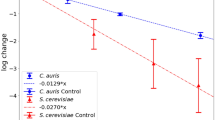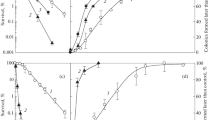Summary
Inactivation of Candida albicans by ultraviolet (uv) light is markedly dependent upon (a) the cell division stage and (b) the nutrition and growth temperatures of cells both before and after irradiation. Cells grown at 37°C after irradiation show lower survivals than those grown at 25°C. At either recovery temperature, cells which had been cultured before irradiation at 37°C are able to sustain less uv damage prior to inactivation than those cultured at 25°C. The radiosensitivities of budding and non-budding cells are the same when survivals are scored at 25°C; at low uv dosages, cells show slightly poorer recoveries on enriched medium than on minimal medium whereas at higher dosages, their recoveries on both kinds of media are equivalent. In contrast, at 37°C, uv treated non-budding cells are much more susceptible to inactivation than budding cells; non-budding cells also express much poorer recovery on enriched medium than on minimal medium at 37°C whereas budding cells survive equally well on either medium. Though non-budding cells grown for irradiation on minimal or enriched media exhibit the same radiosensitivites, budding cells grown for irradiation on enriched medium are more susceptible to inactivation at 37°C than those grown on minimal medium.
The particularly poor recovery by irradiated non-budding cells at 37°C is correlated with their unique tendency to undergo a transitory filamentation when initiating growth at that temperature. Evidence is presented that neither the filamentous growth per se nor the temporary inhibition of cell division associated with filamentation causes the poor recovery. Furthermore, while irradiated non-budding cells at 37°C exhibit singular susceptibility to inhibition of recovery by metabolic antagonists which disturb protein synthesis, the course of their filamentous growth is not affected by such agents. It is concluded that recovery from irradiation and the instigation of cytokinesis by non-budding cells of C. albicans result from different metabolic processes which may be related through a common temperature sensitive step.
C. albicans does not photoreactivate and observations on recovery by cells prevented from undergoing immediate postirradiation replication do not indicate the existence of a system for dark repair of DNA damage comparable to that occurring in bacteria. Difficulties attending a valid demonstration of DNA dark repair in yeasts are discussed.
Similar content being viewed by others
References
Adler, H. I.: The genetic control of radiation sensitivity in microorganisms. In: Advances in Radiation Biology (Eds. L. G. Augenstein, R. Mason and M. Zelle), Vol. 2, pp. 167–191. New York: Academic Press 1966.
—, and A. A. Hardigree: Postirradiation growth, division and recovery in bacteria. Radiat. Res. 25, 92–102 (1965).
Alper, T.: Effects on subcellular units and free-living cells In: Mechanisms in Radiobiology (Eds. M. Errera and A. Forssberg), Vol. 1, pp. 353–512. New York: Academic Press 1961.
—: The effects on irradiated microorganisms of growth in the presence of basic dyes or caffeine. Brit. J. Radiol. 36 861 (1963).
Boling, M. E., and J. K. Setlow: Photoreactivating enzyme in logarithmic-phase and stationary-phase cells. Biochim. biophys. Acta (Amst.) 145, 502–505.
Castellani, A., J. Jagger, and R. B. Setlow: Overlap of photoreactivation and liquid holding recovery in Escherichia coli B. Science 143, 1170–1171 (1964).
Cohen, G. N., H. O. Halvorson, and S. Spiegelman: Effects of parafluorophenylalanine on growth and physiology of yeast. In: Microsomal Particles and Protein Synthesis (Ed. R. B. Roberts), pp. 100–108. London: Pergamon Press 1958.
Demain, A. L.: Nutrition of “adenineless” auxotrophs of yeasts. J. Bact. 88, 339–345 (1964).
Doudney, C. O., B. F. White, and B. J., Bruce: Actiflavin modification of nucleic acid formation. Mutation induction and survival in ultraviolet light-exposed bacteria. Biochem. biophys. Res. Commun. 15 70–75 (1964).
Elkind, M. M., and H. Sutton: The relationship between division and X-ray sensitivity, ultraviolet sensitivity and photoreactivation in yeast. Radiat. Res. 10, 283–295 (1959).
Harris, G.: Nitrogen metabolism. In: The Chemistry and Biology of Yeasts (Ed. A. H. Cook), pp. 437–533. New York: Academic Press 1958.
Hasenclever, H. F., and W. O. Mitchell: Antigenic studies of Candida I. Observation of two antigenic groups in Candida albicans. J. Bact. 82, 570–573 (1961).
Ireland, R., and A. Sarachek: A unique minute-rough colonial variant of Candida albicans. Mycopath. Mycol. Appl. (in press).
Jagger, J.: Photoreactivation. Bact. Rev. 22, 99–142 (1958).
James, A. P., and M. M. Werner: The radiobiology of yeast. Radiat. Bot. 5, 359–382 (1965).
Kantor, G. J., and R. A. Deering: Recovery of division ability in ultraviolet irradiated Escherichia coli induced by photoreactivation, photoprotection and liquid holding treatment. J. Bact. 94, 1946–1950 (1967).
Lerman, L. S.: Structural considerations in the interaction of DNA and acridines. J. molec. Biol. 3, 18–30 (1961).
Loveless, L. E., E. Spoerl, and T. H. Weisman: A survey of effects of chemicals ondivision and growth of yeasts and Escherichia coli. J. Bact. 68, 637–644 (1954).
Lund, A.: Ecology of yeasts. In: The Chemistry and Biology of Yeasts. (Ed. A. H. Cook), pp. 63–91. New York: Academic Press 1958.
Mackenzie, D. W. R.: Morphogenesis of Candida albicans in vivo. Sabouraudia 3, 225–232 (1964).
Maw, G. A.: Incorporation and distribution of ethionine-sulfur in the protein of ethionine-sensitive and ethionine-resistant yeasts. Arch. Biochem. 115, 291–301 (1966).
Patrick, M. H., and R. H. Haynes: Dark recovery phenomena in yeast II. Conditions that modify the recovery process. Radiat. Res. 23, 564–579 (1964).
——: Repair-induced changes in yeast radiosensitivity. J. Bact. 95 1350–1354 (1968).
Patrick, M. H., R. H. Haynes, and R. B. Uretz: Dark recovery phenomena in yeast. 1. Comparative effects with various inactivating agents. Radiat. Res. 21, 144–163 (1964).
Pettijohn, D., and P. Hanawalt: Evidence for repair-replication of ultraviolet damaged DNA in bacteria. J. molec. Biol. 9, 395–410 (1964).
Sarachek, A.: Pseudoprototrophs and the absence of genetic interactions between auxotrophic strains of Candida albicans. Microbiol. Genet. Bull. 20, 15–17 (1964).
—, and J. T. Bish: Postirradiation protein synthesis and the inductions of cytoplasmic and genic mutations in Saccharomyces by ultraviolet radiation. 28, 450–462 (1963).
Scherr, G. H., and R. H. Weaver: The dimorphism phenomenon in yeasts. Bact. Rev. 17, 51–91 (1953).
Setlow, R. B., and W. L. Carrier: The disappearance of thymine dimers from DNA: an error-correcting mechanism. Proc. nat. Acad. Sci. (Wash.) 51, 226–231 (1964).
Setlow, J. K., M. E. Boling, and F. J. Bollum: The chemical nature of photoreactivable lesions in DNA. Proc. nat. Acad. Sci. (Wash.) 53, 1430–1436 (1965).
Sideropoulos, A. S., and D. M. Shankel: Mechanism of caffeine enhancement of mutations induced by sublethal ultraviolet dosages. J. Bact. 96, 198–204 (1968).
Spiegelman, S., H. O. Halvorson, and R. Ben-Ishai: Free amino acids and the enzyme forming mechanism. In: Amino Acid Metabolism (Eds. W. D. McElroy and H. B. Glass), pp. 124–170. Baltimore: John Hopkins Press 1955.
Stapleton, G. E.: Protection and recovery in bacteria and fungi. In: Radiation Protection and Recovery (Ed. A. Hollaender), pp. 87–116. New York: Pergamon Press 1960.
Swenson, P. A., and R. B. Setlow: Effects of ultraviolet radiation on macromolecular synthesis in Escherichia coli. J. molec. Biol. 15, 201–219 (1966).
Szilvinyi, A., and U. Rosenkrantz: Radiation effects on yeast of the genus Candida Berkhout. Nature (Lond.) 190, 1212–1213 (1961).
Tanner, F. W., and E. Ryder: Action of ultraviolet light on yeast like fungi. Bot. Gaz. 75, 309–317 (1923).
Vazquez, D.: Uptake and binding of chloramphenicol by sensitive and resistant organisms. Nature (Lond.) 203, 257–258 (1964).
Witkin, E. M.: Radiation-induced mutations and their repair. Science 152, 1345–1362 (1966).
Author information
Authors and Affiliations
Rights and permissions
About this article
Cite this article
Busbee, D.L., Sarachek, A. Inactivation of Candida albicans by ultraviolet radiation. Archiv. Mikrobiol. 64, 289–314 (1969). https://doi.org/10.1007/BF00417011
Received:
Issue Date:
DOI: https://doi.org/10.1007/BF00417011




